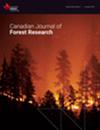Drought-induced growth phenotypes are associated with genetic variation across a white pine hybrid zone.
IF 1.5
3区 农林科学
Q2 FORESTRY
引用次数: 0
Abstract
Understanding relationships among warming climate, increased drought severity, and the genetic architecture of hybrid drought resilience is necessary for forest conservation and management. We calculated three drought-related tree-ring-growth indices (dendrophenotypes) using tree-ring data from hybrid P. strobiformis – P. flexilis study trees at nine sites across Colorado, New Mexico, Arizona, and Texas. Along with hybrid index (percentage of P. strobiformis ancestry inherited by a single tree), and climate variables, we used dendrophenotypes to (Q1) examine relationships among climate and hybrid index, (Q2) examine relationships between dendrophenotypes and hybrid index, and (Q3) conduct a genotype-phenotype analysis. We observed significant correlation between hybrid index and dendrophenotypes resulting from high-temperature drought in addition to significant correlation between those dendrophenotypes and our dataset of single-nucleotide polymorphisms (SNPs). We conclude that P. strobiformis – P. flexilis trees exhibiting higher hybrid indices are more resilient to high-temperature drought events and encourage future research that identifies genetic linkage between relevant loci and their conferred physiological benefits.干旱引起的生长表型与白松杂交区的遗传变异有关。
了解气候变暖、干旱严重程度增加以及杂交种抗旱基因结构之间的关系对于森林保护和管理非常必要。我们利用科罗拉多州、新墨西哥州、亚利桑那州和得克萨斯州九个地点的石南花-柔叶石南花杂交研究树的树环数据,计算了三个与干旱相关的树环生长指数(树原型)。除了杂交指数(一棵树继承的 P. strobiformis 祖先的百分比)和气候变量之外,我们还利用树枝原型来(Q1)研究气候与杂交指数之间的关系,(Q2)研究树枝原型与杂交指数之间的关系,以及(Q3)进行基因型-原型分析。我们观察到杂交指数与高温干旱导致的树枝表型之间存在明显的相关性,此外,这些树枝表型与我们的单核苷酸多态性(SNPs)数据集之间也存在明显的相关性。我们的结论是,表现出较高杂交指数的石南花-柔叶石南花树木对高温干旱事件的抗逆性更强,并鼓励未来的研究确定相关位点之间的遗传联系及其赋予的生理益处。
本文章由计算机程序翻译,如有差异,请以英文原文为准。
求助全文
约1分钟内获得全文
求助全文
来源期刊
CiteScore
4.20
自引率
9.10%
发文量
109
审稿时长
3 months
期刊介绍:
Published since 1971, the Canadian Journal of Forest Research is a monthly journal that features articles, reviews, notes and concept papers on a broad spectrum of forest sciences, including biometrics, conservation, disturbances, ecology, economics, entomology, genetics, hydrology, management, nutrient cycling, pathology, physiology, remote sensing, silviculture, social sciences, soils, stand dynamics, and wood science, all in relation to the understanding or management of ecosystem services. It also publishes special issues dedicated to a topic of current interest.

 求助内容:
求助内容: 应助结果提醒方式:
应助结果提醒方式:


